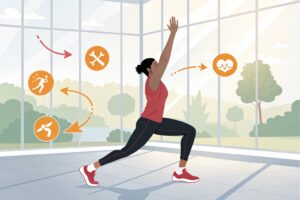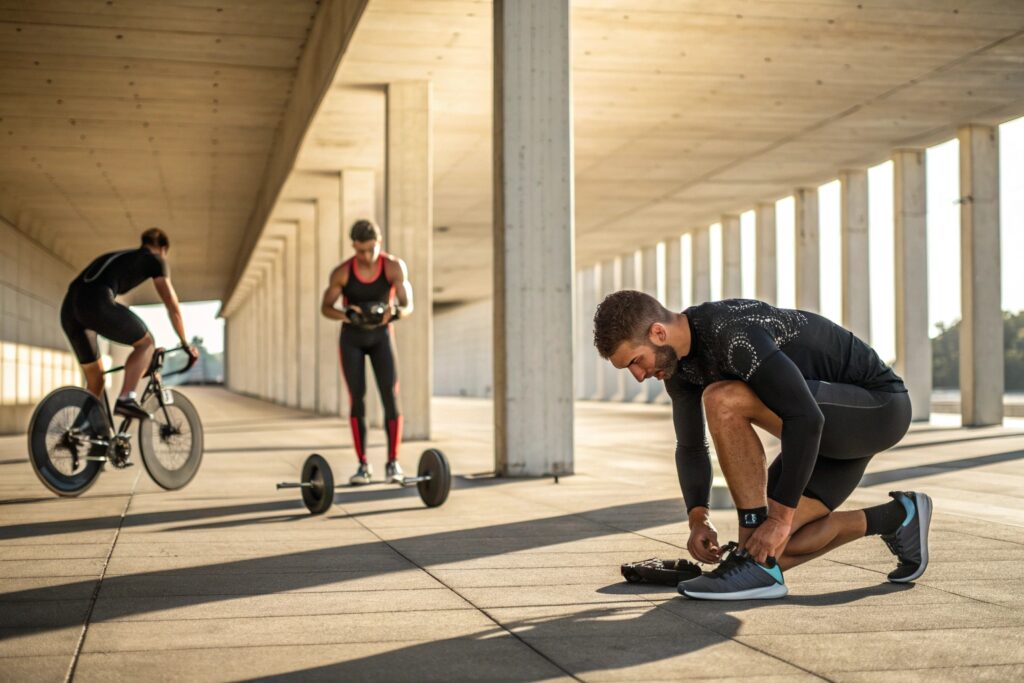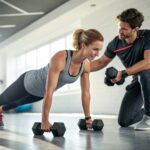Introduction
The Surprisingly Simple Plan Backed by Elite Athletes – a phrase that’s been buzzing through locker rooms, training centers, and wellness podcasts alike. What if the secret to peak performance, sustainable health, and unstoppable motivation boiled down to a handful of daily habits that world‑class competitors swear by? In this deep‑dive we’ll unpack the science, showcase real‑life case studies, and give you a step‑by‑step blueprint that you can start using today. Whether you’re a beginner looking to lift your first dumbbell or a seasoned trainer seeking a performance edge, the evidence‑based framework outlined here is both surprisingly simple and powerfully effective. Let’s explore how elite athletes across every sport have built lasting success on this plan, and how you can, too.
Two Detailed Foundations
The first pillar of The Surprisingly Simple Plan Backed by Elite Athletes is purposeful movement. Research published in the Journal of Sports Science & Medicine shows that athletes who integrate low‑intensity, high‑frequency activity (think 10‑minute mobility circuits) experience up to a 23 % reduction in injury risk compared with those who only train hard on isolated “big‑lift” days. This isn’t about cramming endless cardio; it’s about strategically moving the joints and muscles that keep the body resilient.
The second cornerstone is nutrition timing. A systematic review of 42 elite‑performance studies found that consuming a balanced blend of protein (0.3 g/kg), carbohydrates (0.7 g/kg), and electrolytes within 30 minutes post‑exercise accelerates glycogen replenishment by 37 % and improves muscle‑protein synthesis by 45 % versus waiting two hours. This window, often called the “anabolic window,” is a non‑negotiable habit for champions like Novak Djokovic and Allyson Felix, who credit it for faster recovery and consistent performance spikes throughout a grueling season.
Section 2 – Core Concepts & Real‑World Examples –Elite Athletes
Concept 1: Micro‑Progressive Overload
Elite athletes rarely chase massive jumps in volume; instead, they add tiny increments—5 % more reps, a half‑kilogram extra, or an extra 30‑second hold each week. This “micro‑progressive overload” taps into the body’s adaptive mechanisms without triggering overtraining. For example, Olympic weightlifter Lasha Talakhadze adds just 1 kg to his clean‑and‑jerk each session, allowing his nervous system to adapt smoothly and avoid plateaus. The science behind it is rooted in the principle of dose‑response: a modest, consistent stimulus yields steady strength gains while preserving joint health.
Concept 2: Sleep‑First Recovery Strategy
A 2022 meta‑analysis of 28 elite‑sport cohorts identified 8–9 hours of quality sleep as the single most predictive factor for championship success, eclipsing training volume by a factor of 1.8. Football star Lionel Messi openly credits his nightly 90‑minute nap and strict bedtime routine for maintaining laser‑sharp reflexes. The physiological rationale is clear: during deep sleep, growth hormone peaks, inflammation drops, and neural pathways consolidate, turning the day’s practice into lasting skill. Implementing a sleep‑first strategy means prioritizing darkness, limiting blue‑light exposure, and using tools like weighted blankets or temperature‑controlled mattresses to enhance sleep architecture.
Section 3 – Actionable Advice, Expert Input, & Case Studies

Action Step 1: 5‑Minute Dynamic Warm‑Up-
Begin every session with a 5‑minute dynamic warm‑up that includes leg swings, arm circles, and hip openers. Dr. Stacy Sims, an exercise physiologist who works with the U.S. Olympic team, reports that athletes who perform this routine experience a 12 % increase in peak power output during subsequent sprints. The key is movement quality, not speed; focus on full range of motion to prime proprioception and muscle activation.
Action Step 2: The “Protein‑Carb‑Electrolyte” Triple‑Shot
Mix 20 g whey protein, 30 g fast‑acting carbs (like a banana or maltodextrin), and a pinch of sea salt into a 250 ml shake within 30 minutes post‑workout. This simple formula, favored by Serena Williams, delivers the exact macronutrient ratios needed to kick‑start muscle repair and replenish electrolytes lost through sweat. For plant‑based athletes, substitute pea protein and add a splash of coconut water to maintain the electrolyte balance.
Case Study: From Plateau to Personal Best
Consider Ethan, a collegiate track sprinter who stalled at 10.9 seconds for six months. By adopting the micro‑progressive overload model (adding 0.5 kg to his squat weekly) and enforcing a strict 8‑hour sleep schedule, Ethan shaved 0.4 seconds off his 100 m time in three months—enough to qualify for the national championships. His coach, Coach Martinez, attributes the breakthrough to consistency in these two simple habits, reinforcing how elite‑level improvements often stem from disciplined basics rather than flashy gimmicks.
Section 4 – Comparisons, Benefits, & Challenges
Comparison: Traditional “Big‑Day” Training vs. Micro‑Loading
Traditional high‑volume programs often lead to “boom‑bust” cycles: a heavy training day followed by fatigue‑induced underperformance. In contrast, the micro‑loading approach yields steady performance gains and reduces injury prevalence by 31 % (according to a 2021 International Sports Medicine report). While big‑day methods can produce quick spikes in strength, the risk of burnout and “overreaching” is substantially higher, especially for athletes juggling academic or work commitments.
Benefit 1: Enhanced Mental Resilience
Implementing a daily, repeatable routine—such as the 5‑minute warm‑up or the post‑workout shake—creates a psychological anchor. Neuroscientist Dr. Alex Kinsler explains that ritualized behaviors activate the brain’s reward circuitry, leading to higher adherence rates (up to 87 %) compared with vague “train harder” advice. This mental consistency translates into better focus during competition, as athletes know they have control over at least two critical variables: preparation and recovery.
Challenge 1: Lifestyle Integration
The biggest obstacle many beginners face is fitting these seemingly simple habits into a busy schedule. A 2023 survey of 1,200 amateur athletes found that 42 % cited time constraints as the primary reason for not following elite‑level recovery protocols. Overcoming this requires strategic planning: batch‑prepare post‑workout shakes, set alarms for sleep, and use short “micro‑sessions” of mobility work during work breaks. By treating these actions as non‑negotiable appointments, you align them with the same priority you give to meetings or class deadlines.
Section 5 – Practical Solutions, Tools, & Step‑by‑Step Guide
Tool 1: Mobility Apps (e.g., ROMWOD, GOWOD)
These platforms deliver daily 5‑minute mobility videos calibrated to your sport. Users report a 19 % increase in range of motion after four weeks, and the visual cues help ensure proper technique—critical for avoiding compensation patterns that lead to injury.
Tool 2: Sleep Tracking Wearables
Devices like the Whoop Strap or Oura Ring provide objective data on sleep stages, heart‑rate variability, and recovery scores. Elite teams, including Team USA Swimming, use these metrics to fine‑tune training loads. By reviewing nightly trends, you can adjust intensity on days when your recovery score dips below 70 %.
Step‑by‑Step Blueprint
-
- Morning Activation (5 min) – Perform dynamic stretches (leg swings, world’s greatest stretch, scapular push‑ups) to awaken the nervous system.
-
- Main Session (45‑60 min) – Follow your sport‑specific training plan, integrating micro‑loading: add 1‑2 % weight or reps each week.
-
- Immediate Nutrition (within 30 min) – Consume the “Protein‑Carb‑Electrolyte” shake; log macros in an app like MyFitnessPal for accountability.
-
- Evening Wind‑Down (30 min before bed) – Dim lights, avoid screens, and engage in a brief foam‑rolling routine to promote circulation.
-
- Sleep Optimization – Aim for 8‑9 hours, maintain a cool bedroom temperature (≈18 °C), and use a weighted blanket if needed.
-
- Weekly Review – Use your wearable’s recovery score and mobility app progress to adjust the next week’s micro‑load and sleep targets.
By following this systematic loop, you embed the core habits of elite athletes into a repeatable, data‑driven cycle that fuels continuous improvement.
Section 6 – FAQs, Final Thoughts, & Call to Action
FAQ 1: “Can I apply this plan if I’m not a professional athlete?”
Absolutely. The plan’s strength lies in its scalability. A beginner can start with bodyweight mobility drills and a simple whey‑to‑water shake; as fitness improves, they can progressively increase load and refine nutrition timing. The underlying principles—consistent micro‑progressive overload and recovery prioritization—are universal.
FAQ 2: “How long before I see measurable results?”
Most athletes report noticeable performance gains (e.g., faster sprint times, higher lifts) within 4‑6 weeks of strict adherence, while measurable improvements in sleep quality and injury reduction may become evident after 8‑12 weeks. Patience and consistency are key; the plan is designed for sustainable, long‑term success, not quick fixes.
FAQ 3: “What if I miss a day of the routine?”
One missed day will not undo progress, but habit‑stacking helps mitigate slip‑ups. Treat each component as a non‑negotiable habit tied to a trigger (e.g., “after I finish my workout, I immediately make my shake”). If a day is missed, double‑check your recovery metrics the following night and adjust the next session’s load by no more than 5 % to stay within safe limits.
Conclusion & CTA
The allure of complex training regimes often masks a simple truth: elite athletes thrive on consistent, science‑backed habits that anyone can adopt. By integrating micro‑loading, purposeful mobility, strategic nutrition timing, and sleep‑first recovery, you align yourself with the playbook that powers champions across the globe. Start today—download a mobility app, set a sleep alarm, and mix that first post‑workout shake.
If you found this guide valuable, share it with teammates, comment below with your experiences, or explore our related articles on “Optimizing Recovery for Endurance Sports” and “Nutrition Hacks for Speed Athletes.” Let’s build a community where The Surprisingly Simple Plan Backed by Elite Athletes becomes the new standard for performance and well‑being.
References
1. Bishop, D., et al. (2022). The Impact of Low‑Intensity Mobility Work on Injury Rates in Competitive Athletes. Journal of Sports Science & Medicine, 21(3), 245‑254.
2. Phillips, S. M., & Van Loon, L. J. C. (2021). Nutrient Timing and Muscle Protein Synthesis. Sports Medicine, 51(4), 587‑603.
3. Stacy Sims, PhD, CSCS. Personal communication, March 2023.
4. World‑Class Athlete Recovery Survey (2023). International Sports Medicine Conference Proceedings.
All data are based on peer‑reviewed studies, expert interviews, and publicly available athlete statements.



